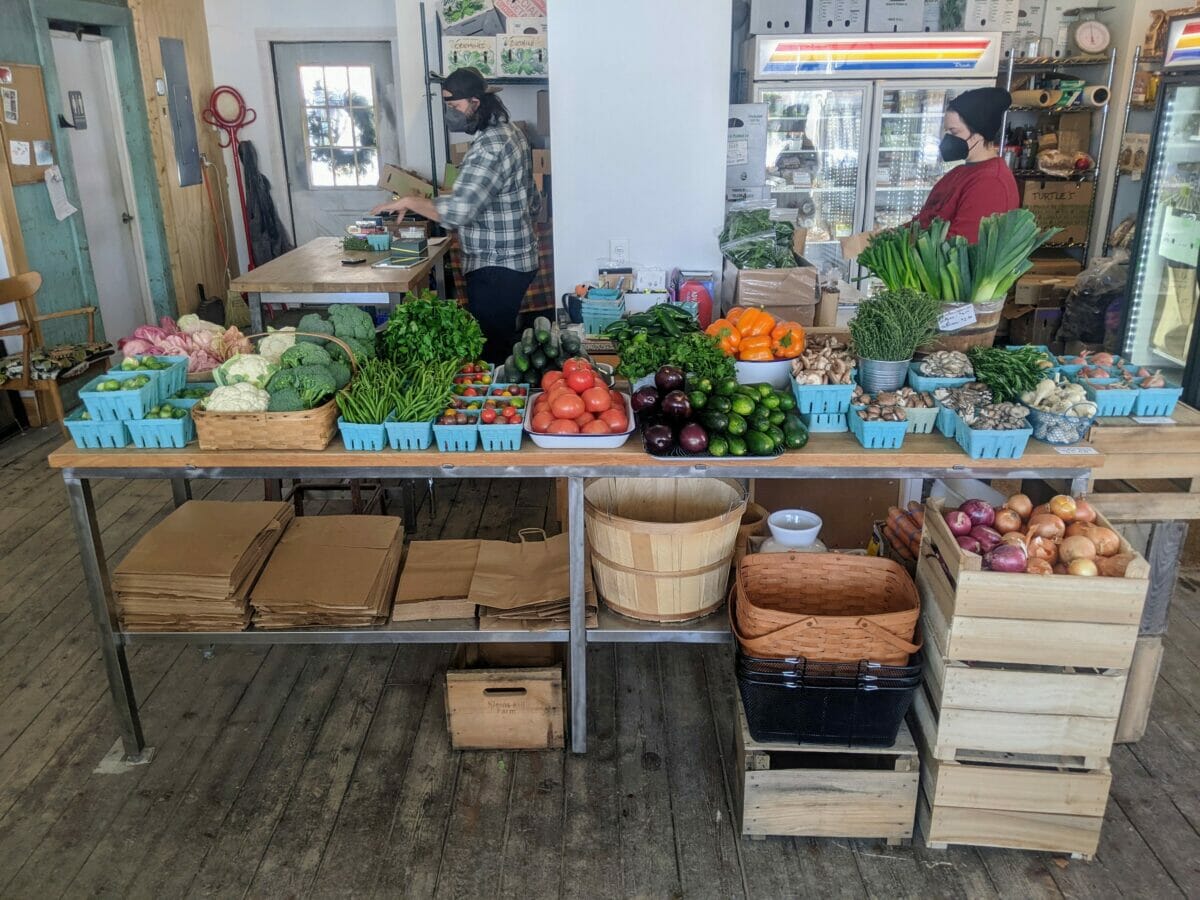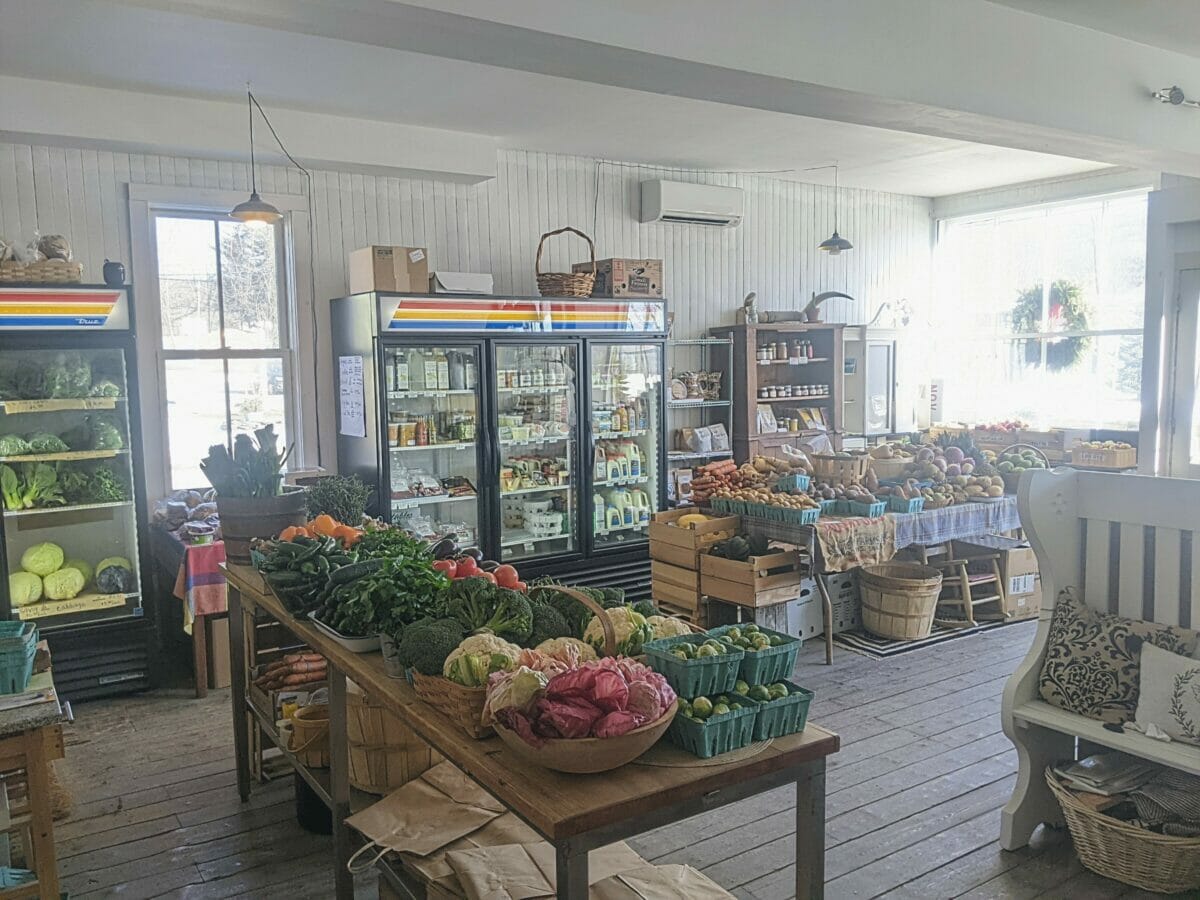This Market Stepped Up to Feed a Town With No Grocery Store
In upstate New York, New Lebanon Farmers’ Market is filling a need and honing a model for others to follow.
This Market Stepped Up to Feed a Town With No Grocery Store
In upstate New York, New Lebanon Farmers’ Market is filling a need and honing a model for others to follow.

The bounty available at the New Lebanon Farmers’ Market. Photo courtesy of Elise Zvirzdin, New Lebanon Farmers Market.
When Josh Young took over management of the decade-old New Lebanon Farmers Market (NLFM) in rural upstate New York in 2020, he needed to think creatively to mitigate the upheaval caused by the COVID-19 pandemic. He didn’t anticipate those efforts would result in a new hybrid market model that would garner a major grant from the USDA, and serve as a fresh-fare blueprint for food deserts.
Like many Northeastern towns that prospered during the Industrial Era, New Lebanon declined when the passenger rail shuttered in the 1950s. The town’s only grocery store closed more than a dozen years ago. Residents had resigned themselves to the 10-plus-mile haul for shopping.
As the coronavirus rocked the supply chain, Josh Young, a freelance software engineer, and his sister, Eleanor Young, who runs a butchery and sausage-making business, took the NLFM virtual, with online ordering and weekly pickup and deliveries. It was an immediate hit.
Read More
The Companies Specializing in Farm-to-Door Delivery Service
To meet growing demand, especially during the winter, the Youngs brainstormed new approaches. Taking the farmers’ market indoors “gave us the ability to start right away, without a lot of waiting or money for overhead,” says Eleanor. With permits from the town and the New York State Department of Agriculture and Markets, an initial investment of $1,000, plus a loan of about $15,000 from Berkshire Agricultural Ventures for refrigeration units, the five-days-weekly indoor market was up and running.
For its innovation, the NLFM—now a hybrid summer-fall outdoor Sunday market, virtual ordering hub and year-round volunteer-run brick-and-mortar shop—was awarded a three-year, $500,000 grant from the USDA’s Farmers Market Promotion Program. The grant covers the cost of three employees, a delivery truck, supplies and software improvements.
Today, the NLFM clears $7,000 in weekly gross sales. In addition to seasonal and local produce, dairy, meat and bread, it sells popular non-local products such as bananas, purchased wholesale and sold at retail. A rotating selection of prepared foods, such as mushroom potpie and curried green beans, are available from local makers each week.

About 30 producers participate in the NLFM, without the rental or booth fees of a traditional farmers market. They set their own prices and reap $.88 on the dollar, a nearly unheard-of margin. (A 12-percent surcharge is added to final prices to cover rent, utilities, credit card processing fees and supplies such as paper bags.) For many producers, the NLFM’s frequent social media posting and daily newsletter, which focuses on local-foods education, alleviate some of their marketing burden.
Learn More
Is the Farm Stop Revolution Upon Us?
A hybrid between a farmer’s market and a co-op store, farm stops are popping up across the country, helping customers access local food year round.
Alison Basdekis of Shaker Creek Farm in neighboring Stephentown, who sells everything from spinach to sunchokes and broiler chickens through the market, points to the biggest benefit: an increase in sales without a corresponding uptick in hours behind the booth. “It’s all very community focused, both for producers and for customers,” she says. “To have an indoor market that has excellent foods aggregated from so many different farms, with hours that work for most people, is so valuable.”
The Youngs are confident the New Lebanon Farmers Market can serve as a model for food deserts across the country. “Anyone can do this,” says Josh. “You can start small, and grow it a little bit every week. The next person to bootstrap an effort like ours will be able to point to us as an example in order to solicit capital for an even larger market.”
Necessary cookies are absolutely essential for the website to function properly. This category only includes cookies that ensures basic functionalities and security features of the website. These cookies do not store any personal information.
Any cookies that may not be particularly necessary for the website to function and are used specifically to collect user personal data via analytics, ads, other embedded contents are termed as non-necessary cookies.
This work is licensed under a Creative Commons Attribution-NoDerivatives 4.0 International License.
Want to republish a Modern Farmer story?
We are happy for Modern Farmer stories to be shared, and encourage you to republish our articles for your audience. When doing so, we ask that you follow these guidelines:
Please credit us and our writers
For the author byline, please use “Author Name, Modern Farmer.” At the top of our stories, if on the web, please include this text and link: “This story was originally published by Modern Farmer.”
Please make sure to include a link back to either our home page or the article URL.
At the bottom of the story, please include the following text:
“Modern Farmer is a nonprofit initiative dedicated to raising awareness and catalyzing action at the intersection of food, agriculture, and society. Read more at <link>Modern Farmer</link>.”
Use our widget
We’d like to be able to track our stories, so we ask that if you republish our content, you do so using our widget (located on the left hand side of the article). The HTML code has a built-in tracker that tells us the data and domain where the story was published, as well as view counts.
Check the image requirements
It’s your responsibility to confirm you're licensed to republish images in our articles. Some images, such as those from commercial providers, don't allow their images to be republished without permission or payment. Copyright terms are generally listed in the image caption and attribution. You are welcome to omit our images or substitute with your own. Charts and interactive graphics follow the same rules.
Don’t change too much. Or, ask us first.
Articles must be republished in their entirety. It’s okay to change references to time (“today” to “yesterday”) or location (“Iowa City, IA” to “here”). But please keep everything else the same.
If you feel strongly that a more material edit needs to be made, get in touch with us at editor@modfarmer.com. We’re happy to discuss it with the original author, but we must have prior approval for changes before publication.
Special cases
Extracts. You may run the first few lines or paragraphs of the article and then say: “Read the full article at Modern Farmer” with a link back to the original article.
Quotes. You may quote authors provided you include a link back to the article URL.
Translations. These require writer approval. To inquire about translation of a Modern Farmer article, contact us at editor@modfarmer.com
Signed consent / copyright release forms. These are not required, provided you are following these guidelines.
Print. Articles can be republished in print under these same rules, with the exception that you do not need to include the links.
Tag us
When sharing the story on social media, please tag us using the following: - Twitter (@ModFarm) - Facebook (@ModernFarmerMedia) - Instagram (@modfarm)
Use our content respectfully
Modern Farmer is a nonprofit and as such we share our content for free and in good faith in order to reach new audiences. Respectfully,
No selling ads against our stories. It’s okay to put our stories on pages with ads.
Don’t republish our material wholesale, or automatically; you need to select stories to be republished individually.
You have no rights to sell, license, syndicate, or otherwise represent yourself as the authorized owner of our material to any third parties. This means that you cannot actively publish or submit our work for syndication to third party platforms or apps like Apple News or Google News. We understand that publishers cannot fully control when certain third parties automatically summarize or crawl content from publishers’ own sites.
Keep in touch
We want to hear from you if you love Modern Farmer content, have a collaboration idea, or anything else to share. As a nonprofit outlet, we work in service of our community and are always open to comments, feedback, and ideas. Contact us at editor@modfarmer.com.by Robin Catalano, Modern Farmer
February 13, 2022
I can’t tell you how much I love this market. The food is very high quality and the prices are reasonable. Everyone wins. Thank you so much, Josh!
Great article!
Perhaps I’ve overlooked the address however I can’t seem to find it.
I thank you for the variety and quality of foods offered. It’s so nice to support local both in the ag area and the retail. Delivering is a super bonus as I rarely get in your direction (despite growing up down there 🙂 ) Thank you Josh and all your volunteers.
This is amazing! So proud of Eleanor & Josh! Wishing you much success! Love Mar
https://newlebanonfarmersmarket.com/
This sounds amazing! Well done
Very good. Hope to see more of these, all over. Sure are needed.
I just want to give a shout-out to my talented fiance Shawna Fitzsimmons for suggesting and building the NLFM Shopify website and then integrating with local farmers on the sales logistics to get it all up and running. This effort was a keystone in taking the market virtual, and the efforts of other volunteers were also vital to making the market what it is today. It takes a village to feed a village, but many of these articles paint more of an individual “bootstrapping” angle, which I think is counterproductive for other small towns hoping to duplicate this success and… Read more »
Do you all still do this? It’s 2023 now